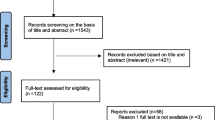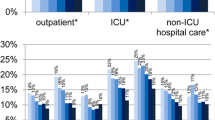Abstract
Our goal was to analyze minimum inhibitory concentration (MIC) data for Staphylococcus aureus isolated from surgical infections (SIs) and to look for correlations among the clinically available antimicrobials that were tested. Clinical isolates from SIs were collected by a multicenter surveillance group involving 34 institutions in Japan. During the period April 1998 to March 2007, 312 strains of S. aureus [71 methicillin susceptible (MSSA) and 241 methicillin resistant (MRSA)] were consecutively obtained from these institutions. MIC data for 18 clinically available antimicrobial agents [ABPC, CEZ, CTM, CMX, CPR, FMOX, CFPM, CZOP, IPM, MEMP, GM, ABK, MINO, CLDM, FOM, LVFX, VCM, and TEIC (abbreviations defined in Tables 2 and 3)] against these isolates was analyzed using a principal component analysis (PCA). PCA revealed that four principal components explained 71.1% of the total variance. The first component consisted of major contributions from MEPM and IPM. The second component consisted of major contributions from MINO. These two-first axes, which were strong and explained 54.2% of the total variance, were able to classify the clinical isolates into four clusters. Furthermore, the proportion of the four clusters provided the characteristics of the S. aureus that were clinically isolated at each institute. PCA is a clinically applicable method for analyzing MIC patterns. Such analyses might contribute to the establishment of a practical classification of antimicrobial agents and to the identification of the characteristic antimicrobial resistance patterns at each institute.




Similar content being viewed by others
References
Shinagawa N, Hasegawa M, Hirata K, Katsuramaki T, Mizukuchi T, Ushijima Y, et al. Bacteria isolated from surgical infections and their susceptibility to antimicrobial agents—special reference to bacteria isolated between April 2007 and March 2008. Jpn J Antibiot. 2009;62:277–340 (in Japanese).
Anderson DJ, Kaye KS. Staphylococcal surgical site infections. Infect Dis Clin N Am. 2009;23:53–72.
Gould FK, Brindle R, Chadwick PR, Fraise AP, Hill S, Nathwani D, et al. Guidelines (2008) for the prophylaxis and treatment of methicillin-resistant Staphylococcus aureus (MRSA) infections in the United Kingdom. J Antimicrob Chemother. 2009;63:849–61.
Stevens DL, Bisno AL, Chambers HF, Everett ED, Dellinger P, Goldstein EJ, et al. Practice guidelines for the diagnosis and management of skin and soft-tissue infections. Clin Infect Dis. 2005;41:1373–406.
Kusachi S, Sumiyama Y, Arima Y, Yoshida Y, Tanaka H, Nakamura Y, et al. Isolated bacteria and drug susceptibility associated with the course of surgical site infections. J Infect Chemother. 2007;13:166–71.
Chambers HF. Methicillin resistance in staphylococci: molecular and biochemical basis and clinical implications. Clin Microbiol Rev. 1997;10:781–91.
Hornstein MJ, Jupeau AM, Scavizzi MR, Philippon AM, Grimont PA. In vitro susceptibilities of 126 clinical isolates of Yersinia enterocolitica to 21 beta-lactam antibiotics. Antimicrob Agents Chemother. 1985;27:806–11.
Sakoulas G, Moellering RC Jr. Increasing antibiotic resistance among methicillin-resistant Staphylococcus aureus strains. Clin Infect Dis. 2008;46:S360–7.
Anderson DJ, Sexton DJ, Kanafani ZA, Auten G, Kaye KS. Severe surgical site infection in community hospitals: epidemiology, key procedures, and the changing prevalence of methicillin-resistant Staphylococcus aureus. Infect Control Hosp Epidemiol. 2007;28:1047–53.
Johnson MD, Decker CF. Antimicrobial agents in treatment of MRSA infections. Dis Mon. 2008;54:793–800.
Cosgrove SE, Qi Y, Kaye KS, Harbarth S, Karchmer AW, Carmeli Y. The impact of methicillin resistance in Staphylococcus aureus bacteremia on patient outcomes: mortality, length of stay, and hospital charges. Infect Control Hosp Epidemiol. 2005;26:166–74.
Cosgrove SE, Sakoulas G, Perencevich EN, Schwaber MJ, Karchmer AW, Carmeli Y. Comparison of mortality associated with methicillin-resistant and methicillin-susceptible Staphylococcus aureus bacteremia: a meta-analysis. Clin Infect Dis. 2003;36:53–9.
Saito A. Clinical breakpoints for antimicrobial agents in pulmonary infections and sepsis: report of the committee for Japanese standards for antimicrobial susceptibility testing for bacteria. J Infect Chemother. 1995;1:83–8.
Kong WJ, Zhao YL, Xiao XH, Li ZL, Jin C, Li HB. Investigation of the anti-fungal activity of coptisine on Candida albicans growth by microcalorimetry combined with principal component analysis. J Appl Microbiol. 2009;107:1072–80.
Lambert RJ. Comparative analysis of antibiotic and antimicrobial biocide susceptibility data in clinical isolates of methicillin-sensitive Staphylococcus aureus, methicillin-resistant Staphylococcus aureus and Pseudomonas aeruginosa between 1989 and 2000. J Appl Microbiol. 2004;97:699–711.
Rambali B, Fernandez JA, Van Nuffel L, Woestenborghs F, Baert L, Massart DL, et al. Susceptibility testing of pathogenic fungi with itraconazole: a process analysis of test variables. J Antimicrob Chemother. 2001;48:163–77.
Seidel V, Peyfoon E, Watson DG, Fearnley J. Comparative study of the antibacterial activity of propolis from different geographical and climatic zones. Phytother Res. 2008;22:1256–63.
Vanjak D, Muller-Serieys C, Picard B, Bergogne-Berezin E, Lambert-Zechovsky N. Activity of beta-lactamase inhibitor combinations on Escherichia coli isolates exhibiting various patterns of resistance to beta-lactam agents. Eur J Clin Microbiol Infect Dis. 1995;14:972–8.
Han LL, McDougal LK, Gorwitz RJ, Mayer KH, Patel JB, Sennott JM, et al. High frequencies of clindamycin and tetracycline resistance in methicillin-resistant Staphylococcus aureus pulsed-field type USA300 isolates collected at a Boston ambulatory health center. J Clin Microbiol. 2007;45:1350–2.
Acknowledgments
The following individuals and institutions participated in the Surveillance Study Group on Pathogens of Surgical Infection: Masamitsu Hasegawa, Department of Surgery, NTT West Tokai Hospital; Koichi Hirata, Tomohisa Furuhata and Tohru Mizukuchi, First Department of Surgery, Sapporo Medical University, School of Medicine; Hiroyuki Osanai, Department of Surgery, Sapporo Gekakinen Hospital; Yoshiyuki Yanai, Department of Surgery, Medical Corporation Teishinkai Shinsapporokeiaikai Hospital; Fumitaka Hata, Department of Surgery, Sapporo Doto Hospital; Kazuaki Sasaki, Tetsufumi Someya, Keisuke Harada and Keisuke Oono, Department of Surgery, Otaru Ekisaikai Hospital; Shoji Tokita and Masashi Nakamura, Department of Surgery, Noboribetsu Kosei-Nenkin Hospital; Hitoshi Shibuya, Department of Surgery, Muroran City General Hospital; Itaru Hasegawa, Masami Kimura, Hideki Oshima and Hideki Maeda, Department of Surgery, Hokkaido Saiseikai Otaru Hospital; Mitsuhiro Mukaiya and Chikasi Kihara, Department of Surgery, Hokkaidou Social Service Association Hakodate Hospital; Watabe Kosho, Department of Surgery, Akabira General Hospital; Tsuyoshi Hoshikawa and Hitoshi Kimura, Department of Surgery, Takikawa Municipal Hospital; Yasuhide Ushijima and Yoo Yae-Hoon, Department of Surgery, National Hospital Organization, Saitama National Hospital; Jiro Yura, Digestive Disease Center, Matsunami General Hospital; Hiromitsu Takeyama and Takehiro Wakasugi, Nagoya City University Graduate School of Medical Sciences, Department of Gastroenterological Surgery; Masaaki Taniguchi, Department of Surgery, Ookuma Hospital; Isamu Mizuno and Takuji Fukui, Department of Surgery, Nagoya Midori Municipal Hospital; Keiji Mashita, Department of Surgery, Bisai Hospital; Syu Ishikawa, Department of Surgery, Kariya Toyota General Hospital, Takahama Branch; Akira Mizuno, Department of Surgery, Inabe General Hospital; Noriaki Moori and Naoki Sumita, Department of Surgery, Chita Kosei Hospital; Shoji Kubo and Shigeru Lee, Department of Gastroenterological and Hepato-Biliary-Pancreatic Surgery, Osaka City University Graduate School of Medicine; Toru Oomura, Department of Surgery, Fujiidera City Hospital; Yasuhito Kobayashi and Takeshi Tsuji, Department of Surgery, Wakayama Rosai Hospital; Hiroki Yamaue and Manabu Kawai, Second Department of Surgery, Wakayama Medical School; Yoshio Takesue, Department of Infection Control, Hyogo Medical School; Noriaki Tanaka, Department of Gastroenterological Surgery, Transplant and Surgical Oncology, Okayama University Graduate School of Medicine, Dentistry and Pharmaceutical Sciences; Hideyuki Kimura, Department of Surgery, Okayama Saiseikai Hospital; Hiromi Iwagaki, Department of Surgery, National Hospital Organization, Fukuyama National Hospital; Taijiro Sueda, Eiso Hiyama, Yoshiaki Murakami, Hiroki Ooge and Kenichiro Uemura, Department of Surgery, Graduate School of Biomedical Sciences, Hiroshima University; Hiroaki Tsumura, Department of Surgery, Hiroshima City Funairi Hospital; Takashi Yokoyama, Aki City Hospital; Hitoshi Takeuchi and Kouji Tanakaya, Department of Surgery, National Hospital Organization, Iwakuni National Hospital; Yoichi Yasunami and Shinichiro Ryu, Department of Surgery 1, Fukuoka University, School of Medicine, and Department of Emergency and Critical Care Medicine, School of Medicine, Keio University.
Author information
Authors and Affiliations
Corresponding author
Additional information
This article is from the Surveillance Study Group on Pathogens of Surgical Infection. The list of individuals and institutions who participated is given in “Acknowledgments”.
About this article
Cite this article
Suzuki, M., Miyaki, M., Sekine, K. et al. Antimicrobial-susceptible patterns of Staphylococcus aureus isolated from surgical infections: a new approach. J Infect Chemother 17, 34–39 (2011). https://doi.org/10.1007/s10156-010-0096-y
Received:
Accepted:
Published:
Issue Date:
DOI: https://doi.org/10.1007/s10156-010-0096-y




